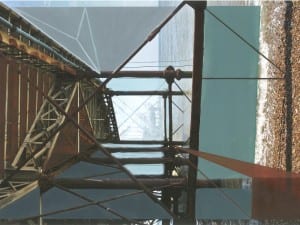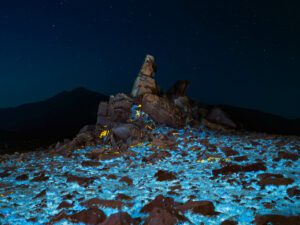Alexej Sachov is a Ukrainian-German artist and diver. His work merges photography and painting to spotlight the beauty and fragility of the underwater world. Sachov studied rocket engineering and photography in Kiev, and his work advocates for environmental protection and peace. His distinctive style transforms underwater photography into compelling contemporary art, bridging the gap between the terrestrial and aquatic realms. It comes from the aftermath of our thoughtless waste, capturing new, man-made underwater species that have emerged. They broaden the idea of “life” on Earth, serving as a testament to the replacement of nature. We caught up with him ahead of the Aesthetica Art Prize Exhibition 2024, which opens on 16 February, and for which he is one of 21 shortlisted creatives.


A: Where did the idea for the project – to make art out of plastic waste – come from?
AS: My first ecological project started after a scuba dive in the Maldives, where I saw clouds of waste materials escaping from drains into the sea. It was then that I started documenting the problem, photographing each plastic piece before collecting it to take out of the water. The specific idea to concentrate on plastic emerged during a workshop at the Kyiv School of Photography, where I was struck by the image of a plastic bag drifting above a road. This inspired me to unite my underwater photographs of plastic entangled in corals or floating in the water into one series: New Cosmos Underwater. Once, after a stormy week, there was too much plastic in the sea to photograph each piece individually – it would have taken too much time. Instead, I collected as much as possible and later created several group photos underwater. Whilst sorting through these pictures, I discovered interesting shapes, which marked the beginning of the series Chronicles of An Emerging Diversity, my shortlisted project.
A: Can you walk us through the steps involved in making one of your images? It must be lengthy!
AS: I enjoy long scuba dives from the shore, during which I have a chance to capture so much beauty. On the other hand, the longer the dive is, the more plastic I end up seeing – and collecting – which can be disheartening. Before coming out of the water, I spend some time photographing what I have found. I take the rubbish out of my pockets and let it hover in the weightlessness. Here, the differing structures and densities of the materials interact, often drifting apart, striving to ascend or sink, thus forming spontaneous and fleeting sculptures in the sea. It’s in these moments that I feel like an astronaut in open space. I adjust the camera diaphragm, darkening the background to a deep, space-like black. Strobes highlight the rubbish and make stars out of particles in the water. The challenges include not losing the plastic parts, maintaining the same depth for safety – and not running into an “out of air” situation!


A: You have a background in rocket engineering and are a passionate diver. How did you get into photography, and how do your various interests inform your work?
AS: I’ve been taking pictures since childhood, but I only started focusing on art photography reasonably recently. This shift was spurred by my love for nature, a desire to take the best underwater pictures, and my ex-girlfriend, who encouraged me to study photography as an art form. Why underwater? I love the sea and the feeling of weightlessness underwater on scuba dives, which is akin to the weightlessness in outer space. So, I love the process itself! In my youth I read all available sci-fi books, and I notice parallels between these texts and my unseen, sometimes surrealistic, scenes.
A: Are you working on anything new right now?
AS: There is quite a lot. I continue to work on projects about pollution as well as the series Blood, which is my emotional reaction to the full-scale Russian invasion of Ukraine. Right now, I’m invested in a creative project that’s all about colours and shapes, and am preparing to publish a book.
A: What are you most looking forward to about the Future Now Symposium and Art Prize Exhibition?AS: In 2023, I visited the Future Now Symposium and the Art Prize Exhibition. It was amazing – the insights from the speeches were enlightening. However, what I found most interesting was the communication with other artists and experts, the possibility to receive feedback in portfolio reviews and the chance to find new contacts or just talk with cool people! This year, I expect even more – three of my artworks will be exhibited, so I anticipate receiving feedback to further improve my artworks!
Sachov will feature in the Aesthetica Art Prize 2024 Exhibition at York Art Gallery from 16 February – 21 April. Plus, meet over 250 longlisted international artists in our new online gallery.
Want to get involved? The next edition of the Prize is open for entries. Submit your work by 31 August. Win £10,000, exhibition and publication. Find out more here.
All images courtesy Alexej Sachov.





